Love the Mower vehicle, certainly very effective at clearing stuff out of the way. Had a go at one donkeys years back, used a spare Us Caboose with a motor and tube that had Strimer Plastic held in place with a screw. Was nit at all effective, I think that the motor was not powerful enough. Also love the Demic overturned Log Disconnects, a very nice touch on a logging line. Was that where they fell naturally?
You are using an out of date browser. It may not display this or other websites correctly.
You should upgrade or use an alternative browser.
You should upgrade or use an alternative browser.
Eltham South Electric Tramway
- Thread starter Melbournesparks
- Start date
NCS from Qbyn
Registered
I like that mower wagon! My railway looks much the same - except that I am blessed with gum trees that shed bark every year - not to mention an almost continuous showering of leaves and "twigs". And then there are those little gum nuts that seem to get into every nook and cranny and foul up the operation of points and derail trains at any opportunity! It makes keeping the tracks clear a bit of a nightmare. It seems almost as soon as you get some track cleared up, the tree litter has blocked the lines somewhere else. I mean trees are good, but not for a garden railwayThe infrastructure improvement program has been making some progress, despite a few set backs. A big milestone recently was re laying the entire section between tunnel 3 and Grasslands Loop with code 250 rail. The old code 332 rail will be cascaded to other areas that specifically require that size of rail.
View attachment 279735
This section is actually pretty good track by local standards now, good for the maximum allowed speed anywhere on the line of 80km/h.
View attachment 279737
In sharp contrast is the section between tunnel 1 and Falls loop, now the only part of the line remaining unchanged since original construction. The tramway was a very different operation in those days, with only small four wheel trams like the Birney here. There's a vague long term plan to eventually make improvements to this section, but for now it remains as is with a 10km/h speed restriction.
View attachment 279738
34M and set arrives back at the depot on a warm summer evening.
We also have some recent video:
The first train of the year was a works train with the mower wagon to clear the line.
Come for a ride in the van up the hill to the depot.
And on the return trip to West Grasslands.
Last edited:
Melbournesparks
Registered
Love the Mower vehicle, certainly very effective at clearing stuff out of the way. Had a go at one donkeys years back, used a spare Us Caboose with a motor and tube that had Strimer Plastic held in place with a screw. Was nit at all effective, I think that the motor was not powerful enough. Also love the Demic overturned Log Disconnects, a very nice touch on a logging line. Was that where they fell naturally?
It definitely needs a fair bit of power to be effective, especially since it has to deal with little twigs as well.
Haha it's a log on a pair of new bright bogies. For a long time it was in the siding that was once there, but the siding was abolished when the main line rail was replaced.
Excellent!
A piece of machinery that does what it says on the tin!
Any chance of a few words and pictures of the beast?
Thanks,
PhilP.
I'll have to take some, unfortunately I wasn't organized enough to actually take any when I was building it. It's pretty basic.
I like that mower wagon! My railway looks much the same - except that I am blessed with gum trees that shed bark every year - not to mention an almost continuous showering of leaves and "twigs". And then there are those little gum nuts that seem to get into every nook and cranny and foul up the operation of points and derail trains at any opportunity! It makes keeping the tracks clear a bit of a nightmare. It seems almost as soon as you get some track cleared up, the tree litter has blocked the lines somewhere else. I mean trees are good, but not for a garden railway
Gum nut stuck in the point blades has definitely caused a derailment here before too. Luckily it's mostly dry environment species around this area that don't drop bark much, just a lot of leaves. Having some sort of rail equipment for clearing them was a must.
Melbournesparks
Registered
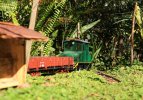
The English Electric loco runs around the train at falls loop. Usually this isn't anything more than a crossing loop, but in this case some wagons were stashed here to free up some space at the depot for other operations.
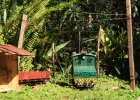
This.. very multicultural set of the Ballarat tram and Sydney B class trailer is definitely not allowed by the Australian rail regulator. Passenger tram trailer operation without continuous brakes was banned long ago, but what they don't know can't hurt them.
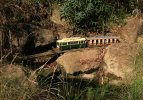
Succulent Valley on the downhill trip. The lack of continuous brakes means a competent staff member to operate the hand brake on the trailer is essential.
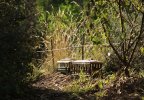
Away from tunnel 3 in the setting sun.
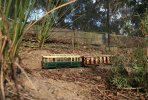
Near tunnel 4.
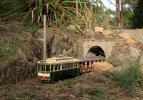
The lower part of the line is pretty easy, Ballarat 33's two braked axles and traction motors are fine for keeping this set under control.

Passing the former site of Gang Gang siding. The motorman will shortly swing the controller to full parallel for the grade ahead.
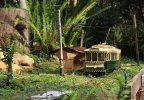
Falls loop in the setting sun.
We also have a bit of video from a very wet day. Too wet as it turns out, the line was impassable beyond Succulent Valley.
That vid was certainly taken on what the Irish would call a ‘soft day’ a most wonderful expression for rain. Perhaps annother avalanche shelter is required at that torrent location? Brill stuff.View attachment 283947
The English Electric loco runs around the train at falls loop. Usually this isn't anything more than a crossing loop, but in this case some wagons were stashed here to free up some space at the depot for other operations.
View attachment 283948
This.. very multicultural set of the Ballarat tram and Sydney B class trailer is definitely not allowed by the Australian rail regulator. Passenger tram trailer operation without continuous brakes was banned long ago, but what they don't know can't hurt them.
View attachment 283949
Succulent Valley on the downhill trip. The lack of continuous brakes means a competent staff member to operate the hand brake on the trailer is essential.
View attachment 283950
Away from tunnel 3 in the setting sun.
View attachment 283951
Near tunnel 4.
View attachment 283952
The lower part of the line is pretty easy, Ballarat 33's two braked axles and traction motors are fine for keeping this set under control.
View attachment 283953
Passing the former site of Gang Gang siding. The motorman will shortly swing the controller to full parallel for the grade ahead.
View attachment 283954
Falls loop in the setting sun.
We also have a bit of video from a very wet day. Too wet as it turns out, the line was impassable beyond Succulent Valley.
Melbournesparks
Registered
Thank you for the updated links, much appreciated.
Am I right in assuming you use track a wire to power the trams?
Assuming I'm correct how do you keep the track and wire clean?
Sorry for all the questions but I'm just starting out in this scale so I am on an information hunt, thanks.
David
No worries!
Yeah both rails are ground, power is supplied by overhead wire. The copper wire isn't actively cleaned by anything other than normal running, Most of the contamination that happens is stuff like dirt, dust, pollen and tree sap physically sticking to the wire, the copper itself still conducts even when weathered.
I have a mix of pantograph, fixed (sliding) trolley pole and trolley wheel equipped stock, when it has been weeks since the last traffic the pantograph stock runs most reliably. The pantographs are most effective at scraping away the dust (where it lands on the car roof and makes a mess, but that's realistic) without becoming dirty themselves. The fixed trolley poles also scrape the wire clean, but because of their small contact area they often collect it on the end of the pole instead where it has to be wiped off every so often. The trolley wheel just rolls over the contamination without scraping it off, so it produces a lot of arcing when the wire is dirty. I have tried in the past using a solvent like WD40 to help the cleaning process, but it just makes the wire sticky so more dust sticks to it. A bit of graphite from a pencil on the pantographs and fixed trolley pole heads helps with lubrication.
Most of my line is at ground level and surrounded by sap and pollen producing vegetation, so how much contamination you have will depend on your environment.
The main contamination I get on the rail head is dust that splashes up when it rains, and vegetation growing over the rails that gets squashed by being run over forming a sticky plant goo. I have a maintenance train that consists of a water tank that drips water onto the rail head and a wooden block that slides along to clean the plant goo off before it builds up too much.
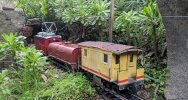
I also have a mower wagon that mows the vegetation between the rails to keep it short. How much of a problem any of those things end up being for you depends on how much vegetation you have growing on the track and how much loose dirt is nearby, but I always took the attitude that trying to control the environment all along the line is difficult so it is better to have maintenance rollingstock adapted to dealing with those problems.
I do like your line. How do your trams stay on the track? If my line gets half that encroached, my trains fall off!
The vegetation isn't very solid compared to the size of the rollingstock so it doesn't present too many problems. I still try and slash it before it impinges on the loading gauge too much though.
Melbournesparks
Registered
Is there some specific image you're looking for? A lot of the old photobucket hosted stuff is hit and miss whether it still works properly.I’ve been unsuccessful in finding the image with the log disconnects.
As usual I had great pleasure catching up in this topic! I LOVE your railway!!!
Thanks Henri!
In post 141 JonD mentions an overturned log disconnect. I had gone back looking and couldn’t find what he was referring to.Is there some specific image you're looking for? A lot of the old photobucket hosted stuff is hit and miss whether it still works properly.
Thanks Henri!
Melbournesparks
Registered
In post 141 JonD mentions an overturned log disconnect. I had gone back looking and couldn’t find what he was referring to.
Ah yes the log bogies as we call them in Victoria. Can be seen at 1:52 in this video:
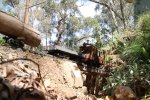
I always meant to make a couple more of these to represent the steam tram motor's later career in the timber industry, but so far this is the only one.
Djjerme
Registered
Love the look of your line, and have been reading this thread for the past several hours.
Question though, what do you do for track laying? Is there a base underneath (I see in some shots drywall screw heads) and then just ballasted, or is it just dry laid on top of the ballast?
Also, do you make your own splits/frogs for the overhead wires?
Question though, what do you do for track laying? Is there a base underneath (I see in some shots drywall screw heads) and then just ballasted, or is it just dry laid on top of the ballast?
Also, do you make your own splits/frogs for the overhead wires?
Melbournesparks
Registered
Love the look of your line, and have been reading this thread for the past several hours.
Question though, what do you do for track laying? Is there a base underneath (I see in some shots drywall screw heads) and then just ballasted, or is it just dry laid on top of the ballast?
Also, do you make your own splits/frogs for the overhead wires?
For the most part the track is laid straight on the ballast, but in places where there is a few joins close together the track is screwed to a wooden base to keep it straight and level.
The frogs are home made from a bit of flat copper with the edges bent over and three holes drilled in it to feed the contact wire though. Hand making them isn't really ideal since they need to all be the same so they have to be fairly accurate, but it is hard to get that sort of thing in this scale.
It is the middle of winter here at the moment so not a lot has been happening. Here is some recent pictures though!
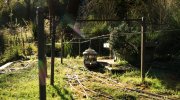
The former heavy rail yard is disappearing into the weeds, only the platform road and the loop get any sort of regular use these days.
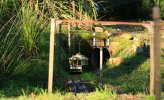
The Ballarat tram trundles off into tunnel 4 on the way home to the depot.
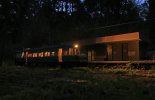
The steam car is finally starting to accumulate the kilometers of reliable operation, seen here at West Grasslands on a cold winter evening.
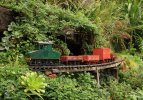
A recent addition to the rollingstock fleet has been a number of little ex Emu Bay railway 4 wheel wagons. These are some prototypes of a very nice 3D printed kit available from North East Works
Chris Vernell
Three score and nineteen
Actually, I believe it's electric.So atmospheric
I see no pipe between the rails.
Clever ClogsActually, I believe it's electric.
I see no pipe between the rails.
